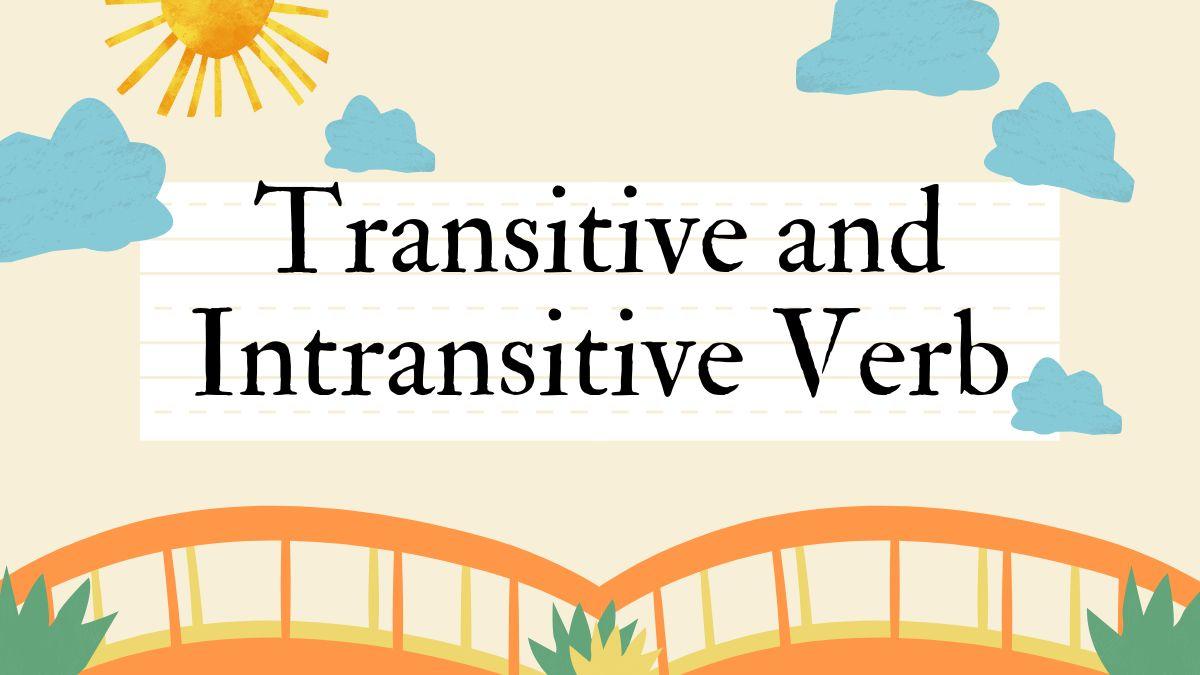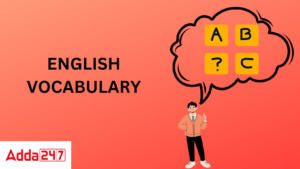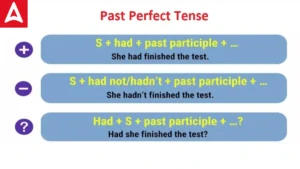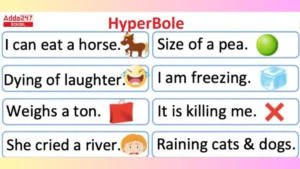The main actors in a sentence are the verbs, which express states, events, and acts. There are two main types of verbs in the English language: transitive and intransitive verbs. Sentence structure and meaning are significantly influenced based on the verbs used. Verbs are descriptive words for deeds or emotional states. They are a fundamental component of all languages, including English.
Transitive and Intransitive Verb Definition
Do you find any difficulty in understanding the transitive and intransitive verbs?? Well, it is not as difficult as you think. With the right approach and concept, one can easily understand this concept in a comfortable way.
In this article, we will learn the difference between transitive and intransitive verbs. Verbs in English can be divided into two groups:
What is a Transitive Verb?
A transitive verb is a kind of verb that requires an object to make complete sense, in general language, we can say that without a transitive verb, the sentence is incomplete without any sense. These verbs are highly important and are the fundamental constituent of English Grammar.
Dictionary Definition of a Transitive Verb
According to the Cambridge Dictionary, a transitive verb is a verb “having or needing an object”. The Collins Dictionary defines a transitive verb as “a verb accompanied by a direct object and from which a passive can be formed, as ‘deny’, ‘rectify’, ‘elect’”. The Merriam-Webster Dictionary gives a similar definition. According to them, a transitive verb is “characterized by having or containing a direct object”.
Examples of Transitive Verbs:-
Correct- Can you bring your notebook to our study group meeting?
Incorrect- Can you bring to our study group meeting?
The verb “bring” requires an object (“your notebook”). It is necessary to state what the speaker is asking to bring.
The instructor addressed the assembly.
The verb “addressed” requires an object (“the assembly”). It is necessary to state what the speaker addressed.
Formation will be-
subject + verb + object
What is an Intransitive Verb?
Well, as you have learned what a transitive verb is, then you can guess right what an intransitive verb is. Yes, you are absolutely correct that an intransitive verb is a verb which doesn’t require any object to complete the sentence or in general, we can say that the sentence can be complete without an object also. However, there are some exceptional verbs which can act as both a transitive verb and an intransitive verb (walk, drive, read, and understand).
Dictionary Definition of an Intransitive Verb
The Merriam-Webster Dictionary defines an intransitive verb as a verb that is “characterized by not having or containing a direct object”. According to the Cambridge Dictionary, an intransitive verb is a verb “having or needing no object”. “A verb that indicates a complete action without being accompanied by a direct object, as sit or lie, and, in English, that does not form a passive” is defined as an intransitive verb, according to the Collins Dictionary.
Examples of Intransitive Verbs:-
Correct- Students laughed at the beggar.
Correct- Students laughed.
Both the sentences are correct if the object would not be used with the verb ‘laugh‘ then also it would be the correct sentence.
Basically, In an intransitive verb if the object is not in the sentence then also it would not create any effect.
Formation will be
Subject + verb + complement(if any)
complement can be an adjective, adverb or object.
Transitive and Intransitive Verb: Examples
To find out the answer to this question just answer the question “subject did what”?
Like in the first example
- Can you bring what?
Your notebook. - The instructor addressed to whom?
The assembly.
Difference Between Transitive and Intransitive Verbs
Let us look at the following table and learn the difference between a transitive verb and an intransitive verb.
| Transitive Verbs | Intransitive Verbs |
| Mandatory to keep an object to make complete sense of the verb or action that the subject is doing. | It’s not mandatory to keep an object to complete the sentence or make sense of the action that is done by the subject. |
| Formation of the sentence generally be
Subject + verb + object |
Formation of the sentence generally be
Subject + verb + complement (if any) |
| A sentence that uses a transitive verb can be changed into a passive voice. | A sentence that makes use of an intransitive verb cannot be altered to form the passive voice. |
| Transitive verbs are followed by an indirect object or a direct object. | Intransitive verbs are followed by either an adjunct or a complement. |
Transitive and Intransitive Verb Exercise
Have a look at the following sentences and find out if the verbs are transitive verbs or intransitive verbs.
1. Joan bought a new car.
2. Audience laughed so hard.
3. The participants passed the pillow around.
4. My friend studied in Korea.
5. Can you pass me some tissues?
6. Rahul came home in the late evening.
7. Cat found her kittens under the table.
8. Angel met his best friend behind the house.
9. The truck stopped suddenly, in the middle of the road.
10. I loved my new bike.
Let’s check how much you score
1. Joan bought a new car. – Transitive verb
2. Audience laughed so hard. – Intransitive verb
3. The participants passed the pillow around.- Transitive verb
4. My friend studied in Korea. – Intransitive verb
5. Can you pass me some tissues?- Transitive verb
6. Rahul came home in the late evening.- Intransitive verb
7. Cat found her kittens under the table. – Transitive Verb
8. Angel met his best friend behind the house.– Transitive Verb
9. The truck stopped suddenly, in the middle of the road.– Intransitive Verb
10. I loved my new bike.– Transitive Verb
Transitive and Intransitive Verbs Exercises with Answers
Exercise 1: Identify whether the verb in each sentence is transitive (T) or intransitive (I).
- She ate an apple. (T)
- The bird flew away. (I)
- He broke the vase. (T)
- The flowers bloomed in the garden. (I)
- They built a sandcastle on the beach. (T)
Exercise 2: Fill in the blank with the appropriate transitive or intransitive verb.
- The cat ______________ on the windowsill. (I) (Answer: sat)
- Sarah ______________ the book to her friend. (T) (Answer: gave)
- The car ______________ loudly. (I) (Answer: honked)
- He ______________ his hand in the air. (T) (Answer: raised)
- The fire ______________ brightly in the fireplace. (I) (Answer: burned)
Exercise 3: Rewrite the following sentences, changing the verb from transitive to intransitive or vice versa.
- He opened the door. (T) -> The door ______________. (I) (Answer: opened)
- The children laughed at the joke. (I) -> The joke ______________ the children laugh. (T) (Answer: made)
- They carried the heavy bags. (T) -> The heavy bags ______________. (I) (Answer: were carried)
- She closed the book. (T) -> The book ______________. (I) (Answer: closed)
- The wind blew the leaves off the trees. (T) -> The leaves ______________ off the trees. (I) (Answer: blew)
Transitive and Intransitive Verbs Worksheet
worksheet on Transitive and Intransitive Verbs to help you practice identifying them.
Transitive and Intransitive Verbs Worksheet with Answers
Instructions:
- Read each sentence carefully.
- Identify the verb in the sentence.
- Determine whether the verb is transitive (has a direct object) or intransitive (does not have a direct object).
- If the verb is transitive, underline the direct object.
Exercise 1: Identify the Verb and Its Type
For each sentence, write T if the verb is transitive and I if the verb is intransitive.
- The cat chased the mouse.
- She laughed loudly.
- He kicked the ball into the goal.
- They arrived late to the party.
- I finished the project yesterday.
- The baby sleeps peacefully every night.
- We baked cookies for the bake sale.
- John sang beautifully during the concert.
- The teacher explained the lesson clearly.
- Birds fly south for the winter.
Exercise 2: Underline the Direct Object (Transitive Verbs)
Underline the direct object in the following sentences with transitive verbs.
- The artist painted a beautiful portrait.
- He borrowed my pen yesterday.
- The chef prepared a delicious meal.
- They built a house near the lake.
- Sarah wrote a long letter to her friend.
Exercise 3: Rewrite the Sentences
Rewrite the following sentences by adding a direct object to make the verbs transitive.
- The dog barked.
- She danced.
- They spoke.
- We walked.
- He jumped.
Exercise 4: Fill in the Blanks
Fill in the blanks with either a transitive or intransitive verb.
- The girl _________ the ball across the yard.
- The sun _________ brightly today.
- I _________ the door before leaving.
- They _________ all night at the party.
- He _________ a letter to his parents.
Answers: Exercise 1
- T (chased)
- I (laughed)
- T (kicked)
- I (arrived)
- T (finished)
- I (sleeps)
- T (baked)
- I (sang)
- T (explained)
- I (fly)
Exercise 2
- The artist painted a beautiful portrait.
- He borrowed my pen yesterday.
- The chef prepared a delicious meal.
- They built a house near the lake.
- Sarah wrote a long letter to her friend.
Exercise 3
- The dog barked a warning.
- She danced the waltz.
- They spoke the truth.
- We walked the dog.
- He jumped the fence.
Exercise 4
- The girl threw the ball across the yard.
- The sun shines brightly today.
- I locked the door before leaving.
- They danced all night at the party.
- He wrote a letter to his parents.
| Related Post | |
| Verb Forms | Auxiliary Verbs |
| Irregular Verbs | Modal Verbs |









 Vocabulary Words with Meaning and Senten...
Vocabulary Words with Meaning and Senten...
 Past Perfect Tense: Definition, Formula,...
Past Perfect Tense: Definition, Formula,...
 Hyperbole- Explanation, Definition, Exam...
Hyperbole- Explanation, Definition, Exam...










